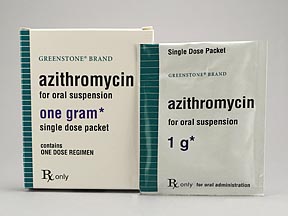
Azithromycin Coupons & Savings Card – Discount Prices from $15.92
Generic for: Zithromax, Zithromax z-pak, Zithromax tri-pak
My prescription
Edit
1GM, Azithromycin (1 Packet)
Select pharmacy

CVS
$34.33
COUPON PRICE
Walgreens
$15.92
COUPON PRICE
Walmart
$23.37
COUPON PRICE
Albertsons
$33.93
COUPON PRICEFree Azithromycin Savings Card

Walgreens
$15.92
Show this coupon to your pharmacist
ID
LHKPA913399
PCN
GDC
BIN
015995
GRP
DR33
This coupon is not insurance
Generic for: Zithromax, Zithromax z-pak, Zithromax tri-pak
More prescriptions for upper respiratory infection
More prescriptions for upper respiratory infection
Price history for Zithromax (brand) & Azithromycin (generic)
1 Packet, 1GM
Average retail price for Zithromax
Average retail price for Azithromycin
Average SaveHealth price for Azithromycin
Our price history data is based on aggregated prescription data collected from participating pharmacies in America. Our prescription data updates daily to reflect the latest price changes. If you notice a missing data point, it means there wasn't sufficient data available to generate a monetary value for that date.
We analyzed Azithromycin prices for (1GM, 1 Packet) over the last 12 months. The average retail price was $138.72, while the average price using the SaveHealth discount card was $40.10. That's a savings of approximately 71.09% when using our Azithromycin coupon.
Compared to the generic version, Zithromax had an average price of $55.20 over the same time period. With the SaveHealth savings card, Azithromycin is 27.36% cheaper on average than Zithromax.
*Retail prices are based on pharmacy claims data, and may not be accurate when we don't have enough claims.
Azithromycin dosage forms
Dosage Quantity Price from Per unit 1GM 1 Packet $17.19 $17.19 1GM 2 Packets $42.39 $21.20 1GM 3 Packets $65.12 $21.71 1GM 5 Packets $99.66 $19.93 1GM 6 Packets $115.99 $19.33
| Dosage | Quantity | Price from | Per unit |
|---|---|---|---|
| 1GM | 1 Packet | $17.19 | $17.19 |
| 1GM | 2 Packets | $42.39 | $21.20 |
| 1GM | 3 Packets | $65.12 | $21.71 |
| 1GM | 5 Packets | $99.66 | $19.93 |
| 1GM | 6 Packets | $115.99 | $19.33 |
Azithromycin Warnings
The following safety information outlines important warnings and precautions associated with the use of azithromycin (Zithromax). Please review this information carefully and consult your healthcare provider if you have any concerns or questions.
Severe Allergic and Skin Reactions: Be aware that azithromycin (Zithromax) can cause severe allergic reactions, which may be life-threatening. Symptoms include facial swelling, hives, rash, and difficulty breathing. Seek immediate medical attention if these occur. Rarely, serious skin conditions such as Stevens-Johnson syndrome (SJS) and Drug Reaction with Eosinophilia and Systemic Symptoms (DRESS) may develop, characterized by rash, blisters, or skin peeling. Discontinue use and seek medical help if these symptoms appear.
Liver Damage: This medication may lead to significant liver issues, potentially resulting in liver failure. Watch for signs like abdominal swelling, jaundice, changes in stool color, nausea, vomiting, confusion, or dark urine. Immediate medical care is necessary if these symptoms arise, and discontinuation of the drug may be required. Individuals with a history of liver problems are at increased risk.
Heart Rhythm Disturbances (QT Prolongation): Azithromycin (Zithromax) can cause serious heart rhythm changes, including QT prolongation, which can be life-threatening. The risk increases with abnormal electrolyte levels, pre-existing heart rhythm issues, or concurrent use of certain drugs. Seek emergency help if you experience chest pain, palpitations, shortness of breath, or dizziness during treatment. Older adults and those with specific health conditions are at higher risk.
Increased Risk of Heart-Related Death: Although rare, some studies suggest a short-term increased risk of heart-related mortality with azithromycin (Zithromax) compared to other antibiotics, particularly within the first five days of treatment. Discuss any concerns with your healthcare provider, who will consider the risks and benefits of this medication for your situation.
Clostridioides Difficile Infection: Azithromycin (Zithromax) may raise the risk of C. diff infection, leading to severe diarrhea. Distinguishing between normal diarrhea and C. diff infection is crucial, as the latter can cause rapid heart rate, foul-smelling diarrhea, fever, and frequent bowel movements. If these symptoms occur, seek medical attention immediately for testing and treatment.
Exacerbation of Myasthenia Gravis: Those with myasthenia gravis may experience worsened symptoms, such as muscle weakness and breathing difficulties. Consult your healthcare provider about alternative antibiotics if you have this condition.
Ineffectiveness Against Syphilis: Azithromycin (Zithromax) does not treat syphilis, and its use may complicate the diagnosis of this infection. If symptoms of a sexually transmitted infection (STI) persist, contact your healthcare provider for syphilis testing.
Contraindications for the use of azithromycin (Zithromax) include:
- Severe allergy to macrolide antibiotics.
- History of severe liver problems linked to previous azithromycin (Zithromax) use.
Always discuss your medical history and any medications you are taking with your healthcare provider to ensure the safe use of azithromycin (Zithromax).
Azithromycin Side Effects
Common side effects:
- Stomach upset
- Diarrhea
- Loose stools
- Nausea
- Vomiting
- Abdominal pain
Less common but important to monitor:
- Oral thrush
- New yeast infection
Serious side effects:
- Changes in hearing
- Eye problems (drooping eyelids or blurred vision)
- Difficulty speaking or swallowing
- Muscle weakness
- Signs of liver problems (persistent nausea or vomiting, unusual tiredness, severe abdominal pain, yellowing of the eyes or skin, dark urine)
- C. difficile intestinal condition (persistent diarrhea, abdominal pain or cramping, blood or mucus in the stool)
- Serious allergic reaction (fever, swelling, rash, severe dizziness, trouble breathing)
Azithromycin Interactions
Interactions with high risk of serious adverse effects and should be avoided:
- Amiodarone
- chloroquine
- disopyramide
- Dofetilide
- dronedarone
- Hydroxychloroquine
- ibutilide
- Pimozide
- procainamide
- quinidine
- Sotalol
Interactions with moderate risk that may require dose adjustment, closer monitoring, or timing changes:
